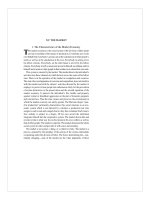Career development interventions 5th by spence niles and bowlsbey chapter 15
Bạn đang xem bản rút gọn của tài liệu. Xem và tải ngay bản đầy đủ của tài liệu tại đây (155.77 KB, 16 trang )
Career Development Interventions
5th Edition
Spence G. Niles and JoAnn E. Harris-Bowlsbey
Publisher to insert
cover image here
Chapter 15
Ethical Issues in Career
Development Interventions
Developed by:
Jennifer Del Corso
Copyright © 2017, 2013, 2009 by Pearson Education, Inc. All Rights Reserved
Classifying Practitioner Behavior
• Ethical and Legal
--------------------------
• Ethical and Illegal
Career Development Interventions, 5th Edition
Spencer G. Niles and JoAnn E. Harris-Bowlsbey
• Unethical and Legal
--------------------------
• Unethical and
Illegal
Copyright © 2017, 2013, 2009 by Pearson Education,
Inc.
All Rights Reserved
Relevant Ethical Codes for Career
Practitioners
• American Counseling Association (ACA)
• National Career Development Association (NCDA)
• American Psychological Association (APA)
• International Association of Educational and
Vocational Guidance (IAEVG)
• American School Counselor Association (ASCA)
Career Development Interventions, 5th Edition
Spencer G. Niles and JoAnn E. Harris-Bowlsbey
Copyright © 2017, 2013, 2009 by Pearson Education,
Inc.
All Rights Reserved
Ethical “Rules of Thumb”
• Dual relationships with the potential to exploit
client trust and vulnerability are unethical.
• Consult with professional colleagues who
understand career interventions when unsure
about how to resolve a dilemma.
• Be aware of client’s values and those imbedded
in career intervention models.
Career Development Interventions, 5th Edition
Spencer G. Niles and JoAnn E. Harris-Bowlsbey
Copyright © 2017, 2013, 2009 by Pearson Education,
Inc.
All Rights Reserved
Ethical Dilemmas vs. Moral
Temptations
• Kidder (1995) contends that an ethical dilemma
occurs only in instances when there are competing
“rights” or there is a struggle to determine the “least
bad” course of action.
• The struggle between right and wrong is seen as a
moral temptation.
• A code of ethics cannot guarantee ethical behavior.
Moreover, a code of ethics cannot resolve all ethical
issues confronting career practitioners.
Career Development Interventions, 5th Edition
Spencer G. Niles and JoAnn E. Harris-Bowlsbey
Copyright © 2017, 2013, 2009 by Pearson Education,
Inc.
All Rights Reserved
Using Principles to Resolve Ethical
Decisions
• Van Hoose (1986) recommended that counselors
use ACA’s five principles to guide their ethical
practice:
Autonomy
Nonmaleficence
Beneficence
Justice
Fidelity (Herlify & Corey, 1996, p. 4-5)
Career Development Interventions, 5th Edition
Spencer G. Niles and JoAnn E. Harris-Bowlsbey
Copyright © 2017, 2013, 2009 by Pearson Education,
Inc.
All Rights Reserved
Additional Principles
• Beauchamp and Childress (2001) identified additional
relevant principles to guide professional-client
relationships:
Veracity: Tell the truth and do not lie or
deceive others.
Privacy: Allow individuals to limit access to
information about themselves.
Confidentiality: Allow individuals to
control access to information they have
shared.
Career Development Interventions, 5th Edition
Spencer G. Niles and JoAnn E. Harris-Bowlsbey
Copyright © 2017, 2013, 2009 by Pearson Education,
Inc.
All Rights Reserved
Virtue Ethics
• Corey and Herily (2006) offer six virtue ethics to
consider:
discernment or prudence,
respectfulness,
integrity,
self-awareness,
acknowledgement of emotions,
connectedness with community.
Career Development Interventions, 5th Edition
Spencer G. Niles and JoAnn E. Harris-Bowlsbey
Copyright © 2017, 2013, 2009 by Pearson Education,
Inc.
All Rights Reserved
ASCA (2010) Ethical Dilemma
Process
Consult confidentially with a professional
colleague
Confront the colleague about the behavior
in question
Document all action steps taken
Utilize the established channels for
addressing ethical concerns
If the matter remains unresolved, contact
the relevant state professional association
or national association
Career Development Interventions, 5th Edition
Spencer G. Niles and JoAnn E. Harris-Bowlsbey
Copyright © 2017, 2013, 2009 by Pearson Education,
Inc.
All Rights Reserved
The Role of Values
• Values assumptions underlie all questions (and answers)
related to ethical behavior in career development
interventions.
• Values are orienting beliefs about what is good for the clients
and how that good should be achieved (Bergin, 1985, p. 99)
• The ACA Code of Ethics (2014) requires counselors to be
aware of the client’s values and the values embedded in
career development intervention models
• Herr and Niles (1988) stress that counselors need to be
cognizant of the values being propagate at the national level
Career Development Interventions, 5th Edition
Spencer G. Niles and JoAnn E. Harris-Bowlsbey
Copyright © 2017, 2013, 2009 by Pearson Education,
Inc.
All Rights Reserved
Progress on Ethical Challenges
Facing Career Counselors
• Standard counseling ethics: confidentiality, counseling
relationships, professional responsibilities, and
relationships with other professionals are clear; while
other ethical requirements are not.
• The National Career Development Association has
developed guidelines for using the Internet in career
service delivery (1) to deliver occupational information,
(2) to provide on-line job searches, and (3) to deliver
interactive career counseling.
• The latest revision of the NCDA (2015) ethical standards
recognizes career professionals’ responsibility for
advocacy on behalf of their clients and for social justice
Career Development Interventions, 5th Edition
Spencer G. Niles and JoAnn E. Harris-Bowlsbey
Copyright © 2017, 2013, 2009 by Pearson Education,
Inc.
All Rights Reserved
NCDA Ethical Standards (2015)
• Section A: The Professional Relationship
• Section B: Confidentiality, Privileged Communication, and
Privacy
• Section C: Professional Responsibility
• Section D: Relationships with other Professionals
• Section E: Evaluation, Assessment, and Interpretation
• Section F: Providing Career Services Online, Technology,
and Social Media
• Section G: Supervision, Training, and Teaching
• Section H: Research and Publication
• Section J: Resolving Ethical Issues
Career Development Interventions, 5th Edition
Spencer G. Niles and JoAnn E. Harris-Bowlsbey
Copyright © 2017, 2013, 2009 by Pearson Education,
Inc.
All Rights Reserved
Ethical Standards and Ethical
Practice for Career Counselors
• Offer only services they are competent to offer.
• Respect and value individual differences among
clients and potential clients.
• Treat information received from and about clients
as owned by the client and held in trust by the
counselor.
Career Development Interventions, 5th Edition
Spencer G. Niles and JoAnn E. Harris-Bowlsbey
Copyright © 2017, 2013, 2009 by Pearson Education,
Inc.
All Rights Reserved
Ethical Standards
continued
• Do not engage in any professional relationship in which
the counselor’s objectivity and ability to work for
client’s welfare might be impaired.
• Assume professional responsibility for clients and, if
unable to assist, help the client obtain alternative
services.
• Recognize they have obligations to other members of
the profession and to society to act in responsible ways
and to consider the effects of their behavior on others.
Career Development Interventions, 5th Edition
Spencer G. Niles and JoAnn E. Harris-Bowlsbey
Copyright © 2017, 2013, 2009 by Pearson Education,
Inc.
All Rights Reserved
Using an Ethical Decision-Making
Model
• Forester-Miller and Davis (1996) provide an
ethical decision making model for professional
counselors that can be applied to career
counseling:
Step 1: Identify the problem
Step 2: Apply the NCDA Code of Ethics
Step 3: Determine the nature and
dimensions of the dilemma
Career Development Interventions, 5th Edition
Spencer G. Niles and JoAnn E. Harris-Bowlsbey
Copyright © 2017, 2013, 2009 by Pearson Education,
Inc.
All Rights Reserved
Using an Ethical Decision-Making
Model
(Continued)
• Step 4: Generate possible courses of action
• Step 5: Consider the potential consequences of all
options and choose a course of action
• Step 6: Evaluate the selected course of action
• Step 7: Implement the course of action selected
Career Development Interventions, 5th Edition
Spencer G. Niles and JoAnn E. Harris-Bowlsbey
Copyright © 2017, 2013, 2009 by Pearson Education,
Inc.
All Rights Reserved









